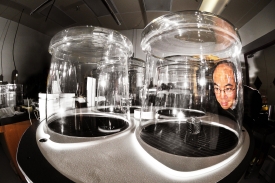Aug 27 2008
The kilogram is losing weight and many international scientists, including some at Sandia National Laboratories, agree that it’s time to redefine it. Scientists are hoping to redefine the kilogram by basing it on standards of universal constants rather than on an artifact standard.
 Hy Tran examines a kilogram sample in a mass comparator at Sandia’s Primary Standards Laboratory. (Photo by Randy Montoya)
Hy Tran examines a kilogram sample in a mass comparator at Sandia’s Primary Standards Laboratory. (Photo by Randy Montoya)
The International Prototype Kilogram (IPK) or “Le Grand K,” made in the 1880s, is a bar of platinum-iridium alloy kept in a vault near Paris.
“The idea is to replace the single master kilogram with something based on physical constants, rather than an artifact that could be damaged accidentally,” says mechanical engineer Hy Tran, a project leader at the Primary Standards Laboratory (PSL) at Sandia.
Sandia is a National Nuclear Security Administration laboratory. Of the seven units of measurement in the International System, or SI, the kilogram is the only base still defined by a physical object. In addition, copies of the kilogram have changed over time by either gaining or losing weight as compared to the standard kilogram.
The purpose of redefining the kilogram is based on risk reduction, says Tran. “In the long term, the redefinition — especially if performed correctly — is beneficial because of risk reduction and because it may enable better measurements in the future,” he says.
By replacing the master kilogram — Le Grand K —with a unit based on physical constants, researchers at multiple laboratories and at national measurement institutes could establish traceability, he says.
Tran says the kilogram will remain the kilogram; it’s only the way it will be defined that will change. He says the earliest the kilogram would be redefined is 2011.
“If and when the redefinition takes place, it will be done in such a fashion as to have minimal or no practical impact with other measured quantities,” Tran says. “In other words, if it is redefined so as to ensure better than 10 parts per billion agreement — rather than 20 parts per billion agreement — then we will see no major changes immediately.”
Based on the current formal definition of the kilogram (the mass of the 1 kilogram prototype) and experimental dissemination to standards labs, the uncertainty (95 percent confidence) in PSL’s kilogram is about 40 parts per billion, compared to the IPK.
One part per billion is about the ratio of the area of a square 3/32 inch on a side, with respect to the area of a regulation NFL football field (including the endzones, or 120 yards by 53-1/3 yards), Tran says.
The target originally proposed by the Bureau International des Poids et Mesures (International Bureau of Weights & Measures) was to get one of the alternative kilogram definitions, such as the experimental measurement of force on the watt balance (or counting atoms on the silicon sphere), and deriving the kilogram, matched to experimental measurements of the prototype kilogram to within 20 parts per billion.
Sandia physicist Harold Parks agrees that the redefinition of the kilogram is inevitable and says there are a couple of issues that need to be resolved before it’s redefined.
“The watt balance method of defining the kilogram makes the most sense for those of us in electrical metrology and so far it is the most accurate,” he says. “But other proposals, such as those based on counting the number of atoms in a silicon crystal, are being considered.”
The watt balance is based on an idea that compares electrical and mechanical power with a high degree of accuracy, he says. Conflicts between the results of the watt balance and the atom counting experiments will also need to be resolved, Parks says.
“The NIST (National Institute of Standards and Technology) watt balance experiment has achieved the accuracy needed to redefine the kilogram, but the experiment will need to be confirmed by other groups in order for the results to be fully accepted,” he says.
Tran says redefining the kilogram will have little impact on the Primary Standards Lab or the broader nuclear weapons complex. The lab develops and maintains primary standards traceable to national standards and calibrates and certifies customer reference standards.
“It should not affect PSL or the complex if the international metrology community ensures that they fully consider the uncertainties, the necessary experimental apparatus to realize the kilogram, and implementation issues prior to agreeing to the redefinition,” Tran says.
In preparation for the change, PSL staff members are staying up to date in research in metrology and standards practices. Staff also participate in standards activities in order to ensure that any transition would be smooth.
For more information on platinum, click here.